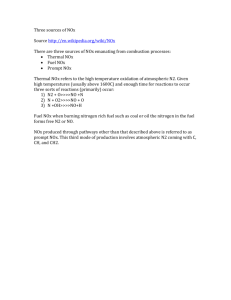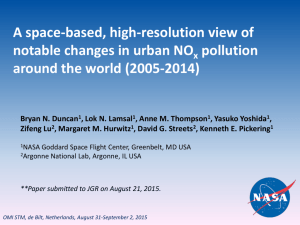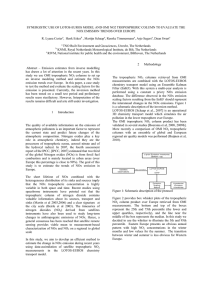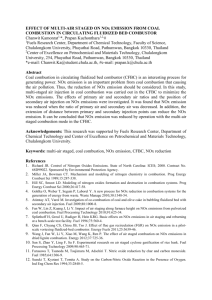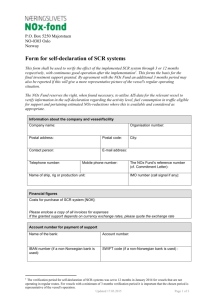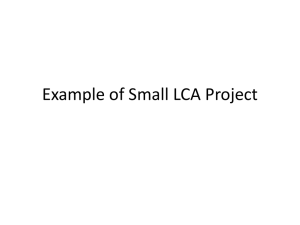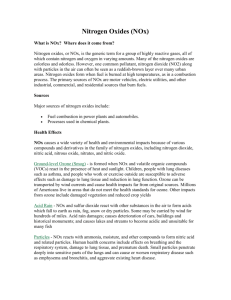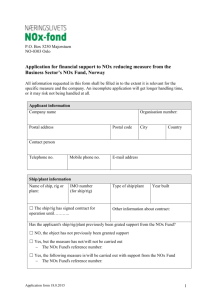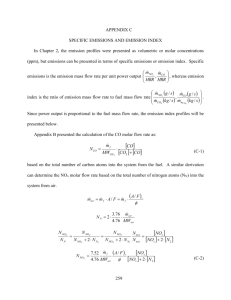Document
advertisement
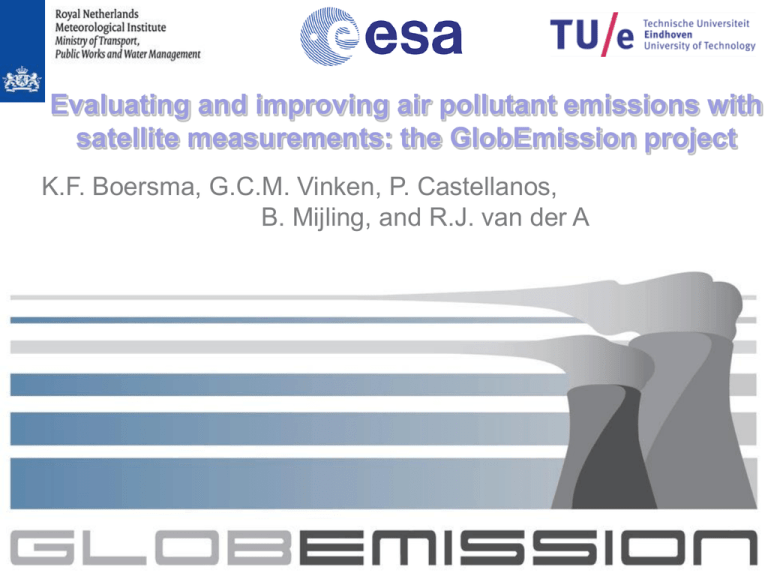
Evaluating and improving air pollutant emissions with satellite measurements: the GlobEmission project K.F. Boersma, G.C.M. Vinken, P. Castellanos, B. Mijling, and R.J. van der A GlobEmission – KNMI/BIRA/FMI/TNO/VITO Committed users • European Environmental Agency (EEA) • University of Edinburgh • Satellite Environment Center (SEC, China MEP) • Indian Inst. of Tropical Meteorology (IITM) • South African Weather service (SAWS) & Department of Water and Environmental Affairs (DWEA) • National institute for Env. Studies Japan (NIES) Specific user requirements: • Species: NOx, CH4, CO, NMVOC, SO2, PM, O3 • Accuracy: better than 30% - 80 % • Spatial resolution: 1 km - 50 km • Time resolution: daily – annual GlobEmission – Approach • Based on satellite observations using inversion techniques • Complementary to bottom-up inventories (not replacing) • Focus on a limited number of species: – NOx, CH4, CO, NMVOC, SO2, PM • Validation with existing inventories and model results • Goal: to demonstrate the validity of the concept Example: regional emission estimates Service provider: KNMI Main users: SAWS (S. Africa), IITM (India), MEP (China) Main tasks: - Derivation of NOx and SO2 emissions using CHIMERE and UV-VIS satellite data - On a 25×25 km2 resolution over China, India and South Africa OMI tropospheric NO2 CHIMERE tropospheric NO2 INTEX-B 2006 Inversion based on • pre-calculated (CHIMERE) local sensitivities to NOx emissions • Kalman filter approach NOx emission estimates for eastern China May – December 2008 NOx emission trend for the Beijing Area 75% 2008 -75% GOME-2 2007 Mijling et al., Geophys. Res. Lett. (2009) OMI GOME-2 Reductions in NOx over Europe (2005-2010) Castellanos and Boersma, Sci. Rep., 2012 2005 2006/2005 2007/2005 Continuous reduction (2004-2010): -2% to -5% OMI Recession Change (2008-2009): -15% to -30% 2008/2005 2009/2005 2010/2005 Reductions in NOx over Europe driven by environmental policy and economic recession Castellanos and Boersma, Sci. Rep., 2012 Similar reductions over the eastern US 2006 2007 2009 2010 2008 OMI Patricia Castellanos 2011 Emissions of NOx (AMVER-ICOADS database) 10 Observations of NO2 (from OMI) OMI 13:30 hrs overpass 13 x 24 km2 pixel 11 First fix the model chemistry: here GEOS-Chem GEOS-Chem plume-in-grid approach for ship emissions Higher OH in early stages of the plume Improved simulations with plume-in-grid show 50% lower NOx concentrations than instant dilution! Vinken et al., ACP, 2011 GEOS-Chem with plume-in-grid (0.50° x 0.67°) A B wind < 6 m/s Vinken et al., in prep., 2012 C Spain – France ship lane Eastern Mediterranean ship lane Tropospheric NO2 [1015 molec./cm2] Tropospheric NO2 [1015 molec./cm2] 1.5 1.0 0.5 0.0 1.5 1.0 0.5 0.0 -1 -1 0 0 GEOS-Chem with 4x AMVERICOADS GEOS-Chem with 4x AMVER-ICOADS DLatitude 1 1 Tropospheric NO2 [1015 molec./cm2] -1 -1 0 0 DLatitude 1 1 2 2 SEE POSTER GEERT VINKEN TODAY! Δlon Δlon 1.5 1.0 OMI 0.5 0.0 1.5 1.0 0.5 0.0 OMI 2 2 Tropospheric NO2 [1015 molec./cm2] AMVERICOADS ship NOx emissions 16x lower Conclusions • ESA GlobEmission project underway to provide space-based emissions of NOx, SO2, CO, CH4,… • Promising hi-res (spatial and temporal) emission estimates • Trends in European NOx emissions reflect a combination of environmental policies and economic activity • Emissions of individual sectors (shipping) can be observed and estimated from space • NO2 satellite data are very useful in evaluating NOx emissions (trends, diurnal patterns, even location), but… • …for proper interpretation, model processes need to be evaluated carefully first (e.g. plume chemistry, diurnal cycle of emissions)

